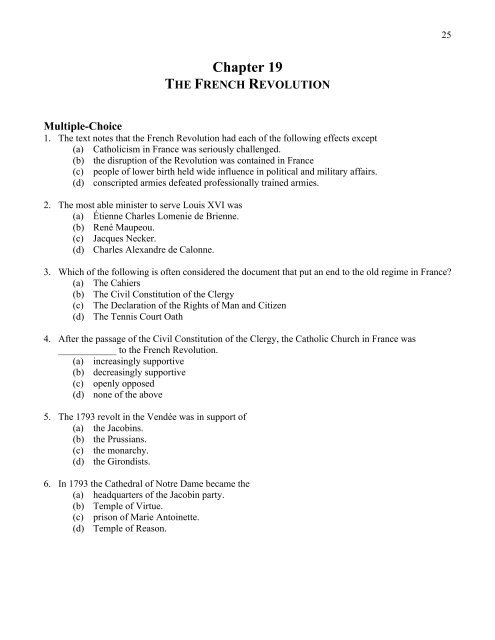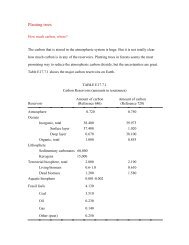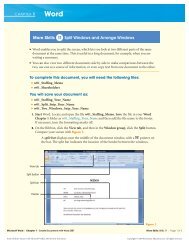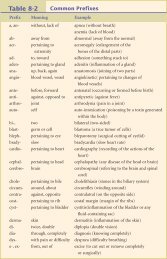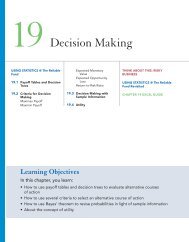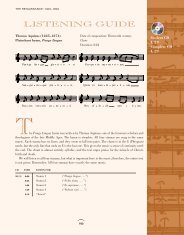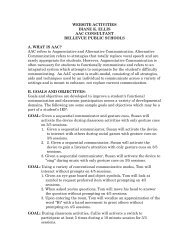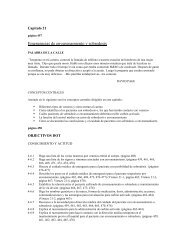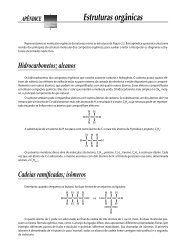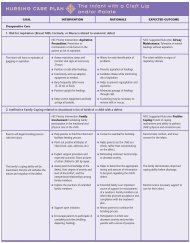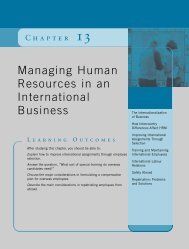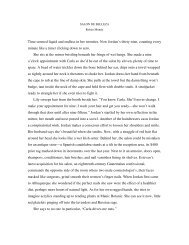Practice Tests
Practice Tests
Practice Tests
You also want an ePaper? Increase the reach of your titles
YUMPU automatically turns print PDFs into web optimized ePapers that Google loves.
Chapter 19<br />
THE FRENCH REVOLUTION<br />
Multiple-Choice<br />
1. The text notes that the French Revolution had each of the following effects except<br />
(a) Catholicism in France was seriously challenged.<br />
(b) the disruption of the Revolution was contained in France<br />
(c) people of lower birth held wide influence in political and military affairs.<br />
(d) conscripted armies defeated professionally trained armies.<br />
2. The most able minister to serve Louis XVI was<br />
(a) Étienne Charles Lomenie de Brienne.<br />
(b) René Maupeou.<br />
(c) Jacques Necker.<br />
(d) Charles Alexandre de Calonne.<br />
3. Which of the following is often considered the document that put an end to the old regime in France?<br />
(a) The Cahiers<br />
(b) The Civil Constitution of the Clergy<br />
(c) The Declaration of the Rights of Man and Citizen<br />
(d) The Tennis Court Oath<br />
4. After the passage of the Civil Constitution of the Clergy, the Catholic Church in France was<br />
____________ to the French Revolution.<br />
(a) increasingly supportive<br />
(b) decreasingly supportive<br />
(c) openly opposed<br />
(d) none of the above<br />
5. The 1793 revolt in the Vendée was in support of<br />
(a) the Jacobins.<br />
(b) the Prussians.<br />
(c) the monarchy.<br />
(d) the Girondists.<br />
6. In 1793 the Cathedral of Notre Dame became the<br />
(a) headquarters of the Jacobin party.<br />
(b) Temple of Virtue.<br />
(c) prison of Marie Antoinette.<br />
(d) Temple of Reason.<br />
25
7. The approximately 25,000 victims of the Reign of Terror were largely<br />
(a) lower class.<br />
(b) clergy.<br />
(c) aristocracy.<br />
(d) none of the above<br />
8. By the end of 1795, legislation in France regarding the status of women<br />
(a) liberalized divorce procedures for them.<br />
(b) supported their involvement in the political process.<br />
(c) upgraded their status in the eyes of the Church.<br />
(d) left them with somewhat less freedom than enjoyed before 1789.<br />
9. The Thermidorean Constitution of the Year III (1795), required that members of the<br />
legislature be<br />
(a) married.<br />
(b) widowed.<br />
(c) female.<br />
(d) none of the above<br />
10. In the latter half of the 1790s, the government of the Directory was primarily supported<br />
by<br />
(a) sans-culottes groups.<br />
(b) the army.<br />
(c) the Catholic Church.<br />
(d) Napoleon Bonaparte.<br />
True-False<br />
_____1. The statement, “What is the Third Estate? Everything,” was made by Louis XVI<br />
on the eve of convening the French Estates General.<br />
_____2. The “Great Fear” occurred in the summer of 1789 as a result of rumors of coming<br />
food shortages.<br />
_____3. One of the major reasons for not immediately repudiating the French national<br />
debt was that much of it was owed to the very people represented by the Third Estate.<br />
_____4. The new currency issued by the National Assembly near the end of 1790 was<br />
backed by lands confiscated from the aristocracy of France.<br />
_____5. The 1792 massacre of persons in Paris jails came to be known as the “October<br />
Days.”<br />
_____6. An example of the effect the French Revolution was having on other European<br />
states was the burning of Alexander Radishchev’s book Journey from Saint<br />
Petersburg to Moscow.<br />
26
_____7. Lazare Carnot, a prominent Jacobin, was responsible for the organization of<br />
republican military armies.<br />
_____8. The so-called enrages were a radical group of sans-culottes that urged greater<br />
price regulations and a more extreme policy of dechristianization.<br />
_____9. The Thermidorean Reaction was chiefly supported by the aristocracy in combination<br />
with the sans-culottes.<br />
_____10. One of the unanticipated results of the Thermidorean Reaction was a notable<br />
revival of Catholicism.<br />
Completion<br />
1. In 1774 _______________ became the king of France.<br />
2. The question of _______________ procedures remained an unresolved problem in 1788<br />
and during the earliest meetings of the Estates General.<br />
3. The taking of the Bastille resulted in the release of _______________ prisoners.<br />
4. The 1791 Declaration of _______________ was an effort by the kings of Austria and<br />
Prussia to protect the French royal family.<br />
5. The most advanced and best organized political group of the National Constituent<br />
Assembly was the _______________ .<br />
6. A 1792 Manifesto issued by the _______________ had the effect of strengthening French<br />
resistance to foreign invasion.<br />
7. The battle of _______________ in 1792 is often considered as the victory of democracy<br />
over aristocracy.<br />
8. _______________ took a position against the French Revolution in his work titled<br />
Reflections on the Revolution in France.<br />
9. In some French cities, Jacobins were murdered in the streets during the Thermidorean<br />
Reaction by gangs of youths known as the _______________ .<br />
10. The term a “whiff of grapeshot” is associated with _______________ .<br />
27
Short Answer<br />
1. Discuss the financial crisis in France on the eve of the French Revolution. Why was<br />
the problem so grave in a country that had considerable wealth? Distinguish between<br />
the rural and urban aspects of the problem.<br />
2. What were the policies of the National Constituent Assembly toward the Catholic<br />
Church? How would these policies “revolutionize” church-state relations throughout<br />
Europe?<br />
3. What caused the Reign of Terror in France? Are events such as this normal in revolutionary<br />
movements? Was there a similar or comparable situation in the American<br />
Revolution?<br />
4. Describe the Thermidorean Reaction. Why should these events be considered as<br />
important parts of the era of the French Revolution?<br />
5. The French Revolution is often characterized as the beginning of the end of the old<br />
regime in Europe, as well as a sign of things to come in the nineteenth and twentieth<br />
centuries. Comment on this statement using appropriate examples as necessary.<br />
28


